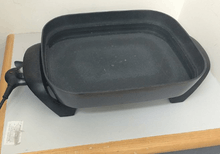Frying pan
A frying pan, frypan, or skillet is a flat-bottomed pan used for frying, searing, and browning foods. It is typically 20 to 30 cm (8 to 12 in) in diameter with relatively low sides that flare outwards, a long handle, and no lid. Larger pans may have a small grab handle opposite the main handle. A pan of similar dimensions, but with less flared, more vertical sides and often with a lid, is called a sauté pan. While a sauté pan can be used like a frying pan, it is designed for lower-heat cooking methods, namely sautéing.
.jpg)
History

Copper frying pans were used in ancient Mesopotamia.[1] Frying pans were also known in ancient Greece where they were called tagēnon (Greek: τάγηνον[2]) and Rome, where they were called patella or sartago. The word pan derives from the Old English panna.[3] Before the introduction of the kitchen stove in the mid-19th century, a commonly used cast-iron cooking pan called a 'spider' had a handle and three legs used to stand up in the coals and ashes of the fire. Cooking pots and pans with legless, flat bottoms were designed when cooking stoves became popular; this period of the late 19th century saw the introduction of the flat cast-iron skillet.
Frying pan relatives
A versatile pan that combines the best of both the sauté pan and the frying pan has higher, sloping sides that are often slightly curved. This pan is called a sauteuse (literally a sauté pan in the female gender), an evasée (denoting a pan with sloping sides), or a fait-tout (literally "does everything"). Most professional kitchens have several of these utensils in varying sizes.
A "rappie pan" is a pan used to make rappie pie, an Acadian potato dish. The pan is made from aluminum or stainless steel.[4]
Construction
Traditionally, frying pans were made of cast iron. Although cast iron is still popular today, especially for outdoor cooking, most frying pans are now made from metals such as aluminium or stainless steel. The materials and construction method used in modern frying pans vary greatly and some typical materials include:
- Aluminium or anodized aluminium
- Cast iron
- Copper
- Stainless steel
- Clad stainless steel with an aluminium or copper core
A coating is sometimes applied to the surface of the pan to make it non-stick. Frying pans made from bare cast iron or carbon steel can also gain non-stick properties through seasoning and use.
Variants
Non-stick
A process for bonding Teflon to chemically roughened aluminum was patented in France by Marc Gregoire in 1954. In 1956 he formed a company to market non-stick cookware under the "Tefal" brand name.[5] The durability of the early coatings was initially poor, but improvements in manufacturing have made these products a kitchen standard. The surface is not as tough as metal and the use of metal utensils (e.g. spatulas) can permanently mar the coating and degrade its non-stick property.
For some cooking preparations a non-stick frying pan is inappropriate, especially for deglazing, where the residue of browning is to be incorporated in a later step such as a pan sauce. Since little or no residue can stick to the surface, the sauce will fail for lack of its primary flavoring agent.
Non-stick frying pans featuring Teflon coatings may give off toxic fumes, as the coating decomposes when heated beyond approximately 240 °C (464 °F).[6][7] Such temperatures can be reached within minutes on gas or electric ranges using high heat.[8]
Electric

An electric frying pan or electric skillet incorporates an electric heating element into the frying pan itself and so can function independently off of a cooking stove. Accordingly, it has heat-insulated legs for standing on a countertop. (The legs usually attach to handles.) Electric frying pans are common in shapes that are unusual for 'unpowered' frying pans, notably square and rectangular. Most are designed with straighter sides than their stovetop cousins and include a lid. In this way they are a cross between a frying pan and a sauté pan.
A modern electric skillet has an additional advantage over the stovetop version: heat regulation. The detachable power cord incorporates a thermostatic control for maintaining the desired temperature.
With the perfection of the thermostatic control, the electric skillet became a popular kitchen appliance. Although it largely has been supplanted by the microwave oven, it is still in use in many kitchens.
References
- Nemet-Nejat, Karen Rhea (1998). Daily Life in Ancient Mesopotamia. Greenwood Publishing Group. p. 126. ISBN 9780313294976.
Copper frying pans were used in ancient Mesopotamia.
- τάγηνον, Henry George Liddell, Robert Scott, A Greek-English Lexicon, on Perseus
- "Pan - Definition and More from the Free Merriam-Webster Dictionary".
- Pamela Goyan Kittler, Kathryn Sucher Food and CultureCengage Learning,2007 ISBN 049511541X, page 519
- Myers, Richard L. (2007). The 100 Most Important Chemical Compounds: A Reference Guide. ABC-CLIO. p. 276. ISBN 0313337586.
- Houlihan 2003 "DuPont studies show that the Teflon offgases toxic particulates at 464 °F. At 680 °F Teflon pans release at least six toxic gases, including two carcinogens, two global pollutants, and MFA, a chemical lethal to humans at low doses."
- Good Eats, Ep. 815 "Myth Smashers"
- Houlihan 2003 "...a generic non-stick frying pan preheated on a conventional, electric stovetop burner reached 736 °F in three minutes and 20 seconds..."
External links

